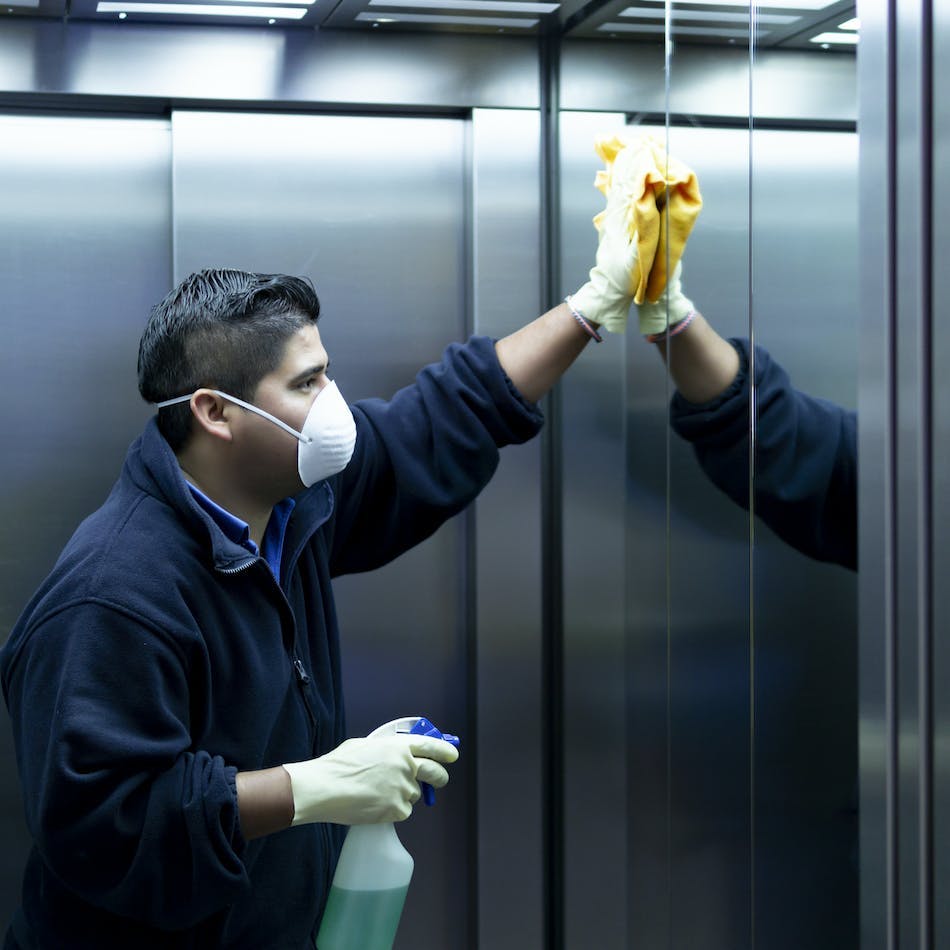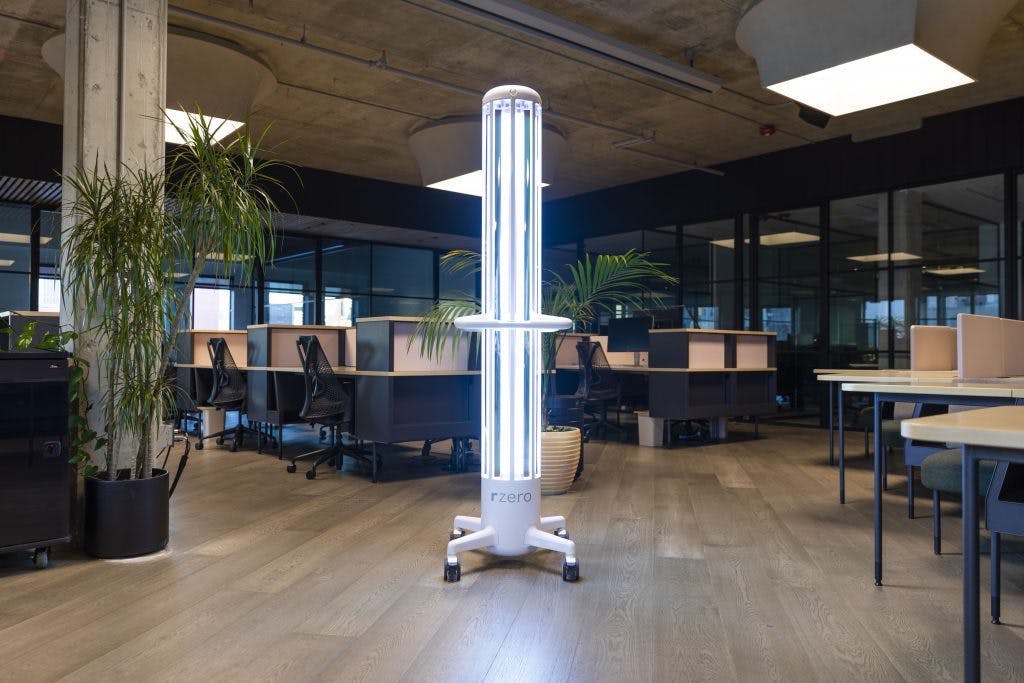New Technologies Make Returning to the Workplace Easier and Safer
By Scott Rhymes | Published April 15, 2021

When a social norm as common as a handshake may go the way of the Dodo bird, we know that new expectations are bubbling to the surface that will influence how we reduce the spread of communicable diseases in the future. The pandemic has taught society, employers, and employees a lot about age-old safety methods and concepts. Now common in our vernacular are terms like social distancing, hazard identification, the hierarchy of controls, MERV ratings, face mask efficiency, ventilation control systems, and many more.
According to the CDC, absenteeism costs US employers ,685 per employee per year in lost productivity due to sick employees (CDC). Other estimates put the overall loss of productivity directly related to the common cold at 5 billion per year (Bramley, Lerner, Sames). These losses include economic loss of productivity and caregiver absenteeism. If the overall spread of disease could be reduced, a reduction in lost workdays would be significant to US employers.
With enhanced societal awareness about disease transmission comes new expectations about maintaining and cleaning our facilities. Also changing is society’s expectation around coming to work sick. In the pre-pandemic world, many of us would go to work ill, knowing there was an expectation to do so or because sick leave policies did not provide enough support for employees to stay home, especially for part-time workers. Absenteeism has traditionally been a focus area for businesses, but we now see more emphasis on presenteeism or working while sick. The reality that we do not want sick employees present in the workplace is now front and center for employers as we experience rising workers’ compensation costs associated with disease transmission in the workplace. Employers should consider a careful review of their leave policies to avoid presenteeism and other safety-related side effects of sick leave policies such as short-cutting procedures or rushing due to staffing shortages.
The pandemic also highlighted the importance of developing comprehensive business continuity plans. A business continuity plan helps companies establish contingency plans for disruptive events enabling quick recovery to pre-defined acceptable levels. Labor shortage contingencies due to the pandemic now need to be included as part of our planning efforts. Being ready for large percentages of your workforce being out sick is now a reality. There are already consulting companies that assist businesses with their business continuity planning process and a few have developed on-line platforms to assist with this process. Agility is a business continuity planning company with a software-based planning tool that can help with the process of developing a business impact analysis, planning and preparation.
As companies continue in their re-opening process, they will need to refer to guidelines set by their state and local health departments. The Centers for Disease Control (CDC), the Occupational Safety and Health Administration (OSHA), and the World Health Organization (WHO) have also published resources and re-opening guides for businesses. Expectations, regulations, guidance documents, and the ongoing development of our understanding of disease transmission will shape how companies will meet the re-opening challenge. A combination of policies, procedures, and technologies will need to be used to reduce risk to our guests, customers, students, and employees.
Attention to our employee’s overall health and well-being is also critical. The National Institute of Occupational Safety and Health (NIOSH) has been researching the concept of Total Worker Health to raise the overall health and safety of employees and lower both health care and workers’ compensation costs. NIOSH has numerous resources and publications to help companies take a more holistic approach to their employees’ health and safety.
To maintain this higher expectation for cleaner and safe workplaces and the lower overall spread of disease, employers will need to continue their evaluation of disinfection chemicals, cleaning protocols, and use of disinfection technologies to ensure they are both providing the results expected and ensure they are safe for use around the public and employees. Some of these existing disinfection chemicals and new technologies can have adverse side effects or health exposures depending on how they are used. These types of exposures also need to be evaluated before use and, in some cases, may require additional engineering controls or personal protective equipment to be used safely.
New technologies are coming to market that have promise in our post-pandemic world. Hardship drives innovation and has provided new technologies and innovative uses for existing tools. Already, the public has made their opinions clear on their desire for increased safety for all. Social distancing, face masks, and installation of physical barriers will continue to be primary control techniques, but there are also new and innovative control technologies to consider. Before an employee arrives at work or a customer enters a restaurant or store, there are methods we can use to reduce transmission of disease. Facilities can use ultraviolet light to disinfect surfaces and the air in a building, we can use touchless infrared screening tools to check for raised temperatures, and we can integrate touchless technology throughout our facility to limit common touchpoints.
** **
UV Disinfection
Once customers, students, patients, or employees leave the workspace, many companies are using chemicals to disinfect surfaces, either via manual wiping or spray systems. While EPA-listed chemical disinfectants can be partially effective, they can potentially bring health consequences for those who come into contact with them. Ultraviolet-C (UV-C) light disinfection systems can provide a safer, faster, and more effective alternative to chemical-based disinfectants.
UV-C disinfection is not new, but its use has climbed in the past year. With wavelengths in the 200-280 nanometer range, UV-C light can inactivate virtually all bacteria and viruses in an indoor space. UV-C light-based systems have been considered the “disinfection” gold standard in hospitals for decades, but historically, most other organizations have been unable to afford the technology. However, the COVID-19 pandemic has driven both new business models and applications of the technology, making it accessible to more organizations for the first time.
R-Zero is a company making hospital-grade UV financially accessible via a subscription lease model. Imagine school classrooms being disinfected each night, hotel rooms between guests, doctor’s office exam rooms between patients, and restaurants and offices nightly by custodial staff. R-Zero’s Arc promises to destroy 99.99% of airborne and surface pathogens without the use of chemical disinfectants. Another UV-C system advantage over traditional chemical-based disinfectants is efficiency. Most chemical disinfectants require varying contact times ranging from one minute to over 20. (Contact time is the amount of time a chemical disinfectant needs to stay wet on a surface, to ensure efficacy.) UV based systems such as R-Zero’s, by contrast, state they can fully disinfect a 1,000 square foot room in as little as 7 minutes. Because UV-C light can be harmful to human skin, comprehensive safety systems including 360-degree motion and heat sensors, countdowns and automatic shut-off have been built into their hardware that prevents any accidental exposure. R-Zero’s Arc system also provides BLE and LTE-based location logging of disinfection activities and custom dashboard integration for a comprehensive record-keeping system.
Screening Entry Tools
The pandemic also brought location arrival screening to many of our daily experiences. We have all now experienced getting our temperature checked in various locations such as the doctor’s office, schools, public buildings, workplaces, government offices, and retail locations. The process requires an employee to check incoming guests and employees to physically check the temperature using touchless thermometers and process the screening paperwork, which puts these employees at increased risk of exposure to this incoming traffic and personal medical information of customers, clients, and employees. In some business cases, hundreds of employees start their shifts together. Having a solution that can work quickly and maintain a touchless interface is essential. Businesses and employers should consider looking at new touchless systems that use camera-based infrared technology. The systems have touch screens but can also be accessed via a linked smartphone app or employer-provided access cards. Companies such as Truyo have developed comprehensive solutions such as their Janus countertop unit to assist with this process. Their screening devices can automate the intake process and keep comprehensive logs on entry, along with keeping personal medical information secure and private.
Touch-Free Technologies
As we move to a post-pandemic world, more businesses are evaluating the need for touch-free systems to interact with their customers and employees. ATMs, ticket dispensers at metro stations or ballparks, grocery stores, and self-checkout terminals are all examples of common publicly accessed touchpoints. Touch-free technologies have been around for years, but recently more uses have been leveraged to reduce the spread of disease. We have all probably seen uses of this technology in public bathrooms, such as touch-free soap dispensers, faucets, toilets, and paper towel dispensers. Most of the technology we have seen in public has been limited to motion sensors.
New technology is already being used and others being developed, such as facial, gesture, or voice recognition, eye tracking, and smartphone integration. Additional touch-free applications are showing up daily in public spaces, smartphone-tied touchless security doors, presence sensing elevator buttons, contactless payment, and many others. Items in the workplace, such as light switches or door handles, can be handled hundreds of times a day by multiple employees. By removing these common touchpoints, we can reduce potential spread.
Going touch-free has other benefits in addition to being more hygienic. Companies such as Steelcase are already developing touchless meeting room reservation systems and automated office density mapping to allow employees to find less populated areas to work. Freetouch, another touch-free-based tech company, offers software that enables users to scan a QR code from their smartphone to control public screen-based terminals. Their technology is already being used in museums to allow guests to control exhibits from their phones. Their interface can be used to modify existing touch interface systems in the workplace and public terminals. Ultraleap, which created a hand motion tracking device, is now producing more advanced hand tracking and sensing tools that can be retrofitted into multiple applications such as elevators. They have even created a technology that allows for touchless haptic feedback that gives the user the sense that they are touching a button in open air. These alternative access methods will also benefit people with disabilities allowing them to use multiple ways to interact with technology.
Employee Density and Social Distancing Tools
Once employees are in the office, on the work floor, or in the lunchroom, we have the added problem of ensuring that proper social distancing and reduced occupancy levels are maintained. New solutions are already on the market that can detect the number of people in a space and provide real-time mapping and alerts. Density is a company that makes sensors that are installed in the workplace to track and monitor population density by location. Some companies have also used personal wearables that offer social distancing reminders. Estimote makes a contact tracing wearable that can track close contacts and provide social distancing reminders when employees get too close.
The pandemic has provided us with a long period of negative impacts, but it may have also substantially changed how society views disease transmission and safety in general. We should look at the lessons learned from the pandemic as an opportunity to improve the overall safety of employees and the public in everything we do. We have learned through this extreme hardship that what was once considered impossible is possible. As we take this newfound superpower of innovation and can-do attitude into the post-pandemic world, we should strive for being better and safer!
Scott Rhymes
Director of Risk Control Services, Newfront
As Newfont’s Director of Risk Control, Scott leads a team of consultants who provide risk control and safety consulting services to clients designed to lower our client’s total cost of risk. Newfront risk control consultants partner with clients to increase risk awareness and reduce occupational, property, liability, and auto exposures by focusing on the client’s overall safety and risk management systems. Scott has over 27 years of experience in the risk management field, including direct employer-side experience directing programs for large municipal infrastructure districts, manufacturing and logistics, and biotech. Scott is also a regular guest speaker at local industry groups and university certificate programs.
Connect with Scott on LinkedIn

